ROONIO BUILD PART THREE
Serendipity
By Bill & Paul Moffitt
Part One - Part Two
July 4th saw Paul driving down from Philadelphia and us coming up from Atlanta, GA. We met in Atlantic Beach, North Carolina, not too far from Kitty Hawk; good winds guaranteed, right? Paul had not completely finished Roonio (are these boats EVER finished?) so we had a days work to do first. I brought my Michalak WOOBO and Sean’s and Lauren’s Slam Dink as well. This was the scene in the garage.

Paul with Roonio and my Woobo; work still to be done!
(click images for larger views)
We got the tillers painted and installed, figured out where and how to mount the sheet leads for larger non-stock sails (thanks to Jeff for figuring that out!), replaced mast hoops with larger ones that wouldn’t bind, kick-up rudder retract system, and a bunch more. Then all went down to the beach to be assembled.

Sheet lead giving 3 to 1 purchase, a clear bridgdeck and no tiller interference. The black sheave is mounted on an eyebolt also used to mount bridgdeck beam to hull.

Roonio, now christened Serendipity, out in the water for the first time. Not so many people needed, but everyone wanted in on it.
The first sail was short and bitter sweet. She sailed well enough, but before we could get going well, after about 20 minutes, the starboard mast tube was seen to be rising out of the hull! Then the port tube followed just after we got the first mast down on deck. Turns out Paul had not prepped the schedule 40 plastic tube well enough and the epoxy did not get a good bite. Combined with my changing the halyard cleat from mast to mast-tube, this caused the tube to pull right on out. Repairs were done next day. No more problems there.
Next sail was with one mast only, per Jeff’s suggestion, which we ignored the first time, and all went much better. We added a rudder hold down method to the retract system to aid a slight insufficiency of lead in rudders which works quite well. Simple, adjustable, efficient. Bungee pulls down, cord pulls up.
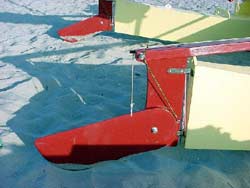
Per NOAA, winds were 10 mph, waves 1-2 ft. We had also added the lee board by now.
We spent 2.5 hours out there this time and what a difference! 5.5 Nautical Miles with moving average of 2.7knts and max speed of 6.2Knts. All following sailing was with both sails.
Jeff advised us that our rig, at best point of sail, with 10 Mph of wind and 2 sails will produce only 1 Hp! He also said that is not enough to get past the monohull/hull speed of 2.8 for Roonio, so the numbers match. Not too exciting, but we hoped for more wind later!
Jeff calculates 4 Hp at around 20 of wind. How sweet would that be!?
Rather that give a long, boring ships log report, I will do some summarizing while throwing in some more pictures. We never did get the wind we wanted. Always about 10 mph. Sometimes 15 predicted for late afternoon. Could have reached that, but didn’t feel like it. I feel like we cheated Jeff and Roonio by not being able to showcase her capabilities within the designed range. My Kitty Hawk plan failed!
Paul is moving house now and catching up on lost work during sailing vacation, so it may be a while till he can go out again. It will be lake sailing at that time.
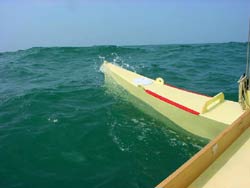
Three people on board, probably 5 Knots into wind/waves. Small Flat on bow will be made round or pointed with foam/glass or wood to eliminate spray; though it was always refreshing!
About the 4th time out we tried an experiment. Predicted winds were 10-15 mph. We pointed up into the wind till we only made 3 Knots and held it there. Our bearing was 205 degrees at that time. We then raised the lee board; same heading of 205, but the speed fell to 2.5Knots. We held these speeds for 2-3 minutes each and were satisfied that they were good.
Back on shore about 1.5 hours later, I checked the wind direction at 230 degrees. Neighbor’s windsock looked the same as before we went sailing and winds were almost always from the same direction the while we were there. Sailing 25 degrees off the wind seems awfully good to me; I wonder what we got wrong? Could it have been that good?
Our moving average was around 2.5-2.9 knots every time we went out. But we regularly reached 5-7 knots when we sailed the right direction. Maximum speeds recorded by 2 GPS units were from 8 to 11.8 knots over 9 outings. Probably running down the backs of waves.
The first 2 times out we couldn’t tack at all! But jibbing was gentle and sure. By sail number 3 we got the technique down and almost never got caught in stays thereafter. It is a learning process!
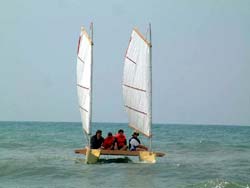
Here we are with 4 on board, about 625 lbs! Serendipity still sailed well, though slower, and we got splashed a lot more, but she WILL carry a load!
We also went out once with 715 lbs; Serendipity took it in stride.
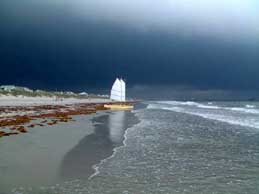
Serendipity with thunder storm approaching. Too bad there was lightning, we would have loved to take advantage of some of that wind!
When broad reaching, the windward sail tends to blanket the lee sail. Remember we are talking 10+mph, so little chance of shifting the relative wind much. We found that “spilling” the windward sail allowed the lee to draw and good progress was made. Following pictures were taken from a dock at a longer range that wanted, so resolution isn’t the best.
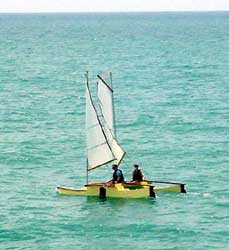
Spilling wind on a broad reach. Note windward sail angle of attack compared to lee sail..
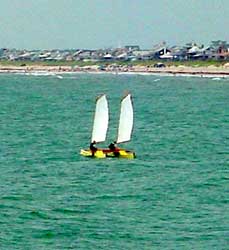
Pointing up into wind. (Excuse resolution!)
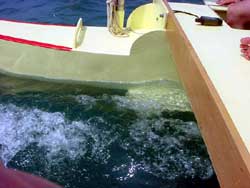
Serendipity’s wings at work.
The combination of hull form and wings works. We did not know how to measure leeway, but one could sail and make head way without the lee board. But the lee board made a difference; you could tell when it kicked up, if not immediately, then soon after, depending on point of sail. I do wish we had been able to get more data on this, but we didn’t – more fun to sail!
SHACKLEFORD ISLAND
The day before Paul packed up and left, we made a trip to Shackleford Island, uninhabited save for wild horses and tourists. One way distance 4.35 Knots Miles as the crow flies. Winds were VERY light in AM barely 5 mph. We had to run to the beach for a thunder storm with lightning; only wind that morning and we had to sit it out! Up to 10 mph by the time we had to cross the Beaufort Channel. Tide in full flood and we had to row about 15 strokes to make it into small bay through the tidal race.
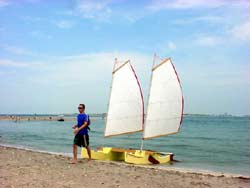
Paul and Serendipity on the beach at Shackleford Island.
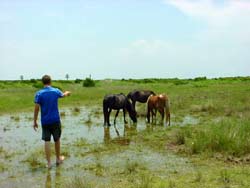
Feeding the feral horses.
We brought a bite of lunch and after eating had to wait 2.5 hours for high tide to get out of the channel. Paul broke out a flask of bourbon. This called for a nap, which Paul caught on memory chip.
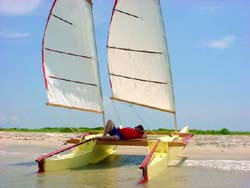
Nap time!
Getting out of the channel was difficult. Paul finally figured out we should not tack across the full channel, but only use the western half. Soon we were out where we could get a better point of sail down the beach to home. Winds had picked up by then and we showed a regular 5.5 Knots against the current! Finished up tired but very satisfied with Serendipity. Her skills far outweigh ours for now.
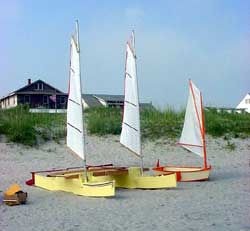
Serendipity and Slam Dink ready to go…
( I love this picture!)
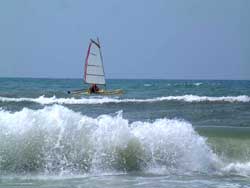
Three on board and outside the surf.
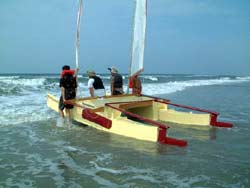
Lee board visible as we head out for one more sail, this time with four.
I write this as the proud father of the builder. This was Paul’s 2nd boat, the first a Michalak Larsboat. He had some things to learn. I will let him detail what he thinks is important. The Roonio design was not intended to be used as we intend to use it, but Jeff Gilbert made a few adaptations and it is a good design. We were regularly in 2-4 foot waves and pressing into what wind there was. Bridgdeck twisted with the sea but never cracked or showed signs of failure. The mast tube debacle was not a design fault, but one of technique. Kudos to Jeff for a simple to build, fun, efficient, and character-full design.
We made one “major” change, namely the bridgdeck beam extensions and footwell/hiking seat covers.
Perhaps Jeff summarizes it best this way;

